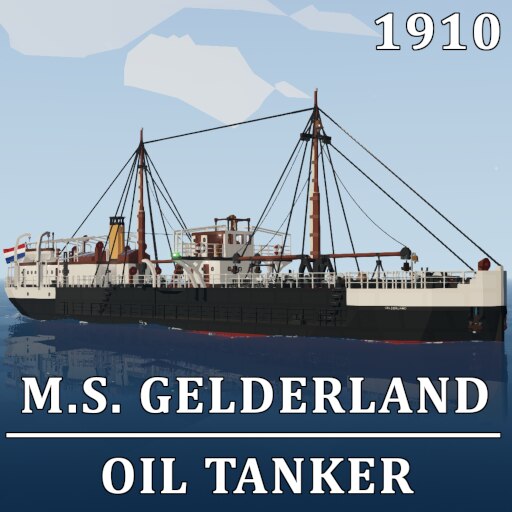M.S. Gelderland 1910 | Dutch Oil Tanker
Discord server for checking out how the latest builds are coming along, chatting, memes, the occasional build competition and other nonsense: https://discord.gg/7Z2VWqvDwq
(Fictional)
As volatile liquids became more common in industrial uses, inevitably ships had to be specially built for carrying them. At the same time, the diesel engine quickly developed to the point where it could go to sea. One company, fearing that the sparks from the boilers of a steam engine could set fire to the frightening freight, decided to combine these two innovations (along with a turret deck hull for some reason) to build an efficient, safe, and revolutionary ship. The M.S. Gelderland, though facing to teething troubles at first, would prove to be exactly that, and it wasn’t long before motor ships started popping up around the world, eventually displacing the old steam engine.
Top speed: 10.5 Knots fully loaded, 11.9 Knots empty
Length: 56.5 Meters
Width: 10.75 Meters
Height: 19.75 Meters
Draft: 4 Meters fully loaded
Engine Type: x1 6 cylinder diesel engine, started using compressed air, recreated as closely to the ships real-life counterpart’s engine as I could given the info I could find
Fuel Capacity: 36,937 Liters split between two tanks for the main engine, 3,109 Liters for the air compressor, 1,671 Liters for the dynamo
-Accommodations for:
5 Officers including the captain
4 Engineers
6 Crew
-1 Main helm and auxiliary helm
-6 Cargo oil tanks
-7 Conventional cargo holds, 6 small holds atop the oil tanks, 1 largo hold at the bow
-4 Cargo derricks
-1 Crank started air compressor
-1 Crank started dynamo
-3 Circuit breakers with an electric switch gear
-3 Cofferdams with maintenance hatches
-2 accessible main fuel tanks for the main engine, and 2 auxiliary tanks for the dynamo and air compressor
-2 Anchors
-2 Lifeboats
-2 Bilge pumps
-1 Bell
-1 Horn
-Simulated cold starting smoke (basically the engine produces visible smoke when cold)
-Various ship paintings
-1 Galley and scullery
-1 Officer’s mess
-1 Crew mess
-1 shower
-1 toilet (please do not be harsh with it)
-1 Chart room with map
-1 Paint locker, lamp room, linen closet, cold weather gear closet, equipment locker, engineer’s stores, boatswain’s stores, and pantry
-Various handheld equipment stored throughout the ship (including fishing poles to go with the hoppers in some of the cargo holds!)
-Full interior
1: Head down to the engine room, the center door on the front of the aft deckhouse.
2: On the starboard (right) side, turn on the the dynamo and start it using the handcrank.
3: Up on the upper part of the engine room, turn on the electric switch gear and circuit breakers and now you can turn on the lights.
4: Back down and to the port (left) side, turn on the air compressor and start it using the handcrank, and set the throttle to what you need it to be. (3.5-4 for just driving, full throttle for cargo or bilge pumps.)
5: With sufficient air pressure for starting the engine, simply set the engine telegraph forward/backwards to start moving.
The air tanks are at the maximum pressure (60) by default.
The engine relies on air pressure to both start and run. You need to have the compressed air tanks full at all times if you want to go at the maximum speed, and the engine cannot idle (run at 20% throttle) at pressures below 45.
The ship spawns with all tanks completely full of diesel by default. If you want it empty, just go in the workbench and crank the fluid spawners that are under the support pillar closest to the ladder (furthest for the forward two tanks) to zero.
There are six tanks, with small holds for conventional cargo on top, each with their own valve that is controlled on deck next to the cargo hatches.
There are two pumps, one for the 3 port side tanks and one for the 3 starboard tanks.
The Cargo Pump Valves turn on the cargo pumps themselves, which are run by compressed air, the Port and Starboard Tank Valves each control flow to the Port and Starboard sets of tanks, and the Intake/Discharge valves are, well, fairly self-explanatory.
To be able to unload quickly, the tanks use a system of pressurizing the tanks with compressed air to force the cargo out quickly, resulting in the ship being able to unload cargo at a rate starting at around 70 LPS, stabilizing to about 65-60 and gradually slowing as the tanks empty. (Assuming the container you’re pumping into isn’t fighting back)
For loading, I tried to do the reverse with a vacuum system, but I can’t seem to get it to load quickly. Using an external pump from what you’re getting the cargo from is recommended.
To quickly relieve pressure in the tanks for loading, simply open the maintenance hatches in the cargo holds.
The ship uses impeller pumps for the cargo, so you should be able to override them with more powerful pumps if you have them.
Testing show you can transfer cargo between a full Gelderland and a nearly empty Gelderland at a rate of roughly 34 LPS.
There are no ballast tanks, so you may need to trim the cargo itself to keep the ship on an even keel.
No, there aren’t any sink switches.
Yes, I am aware the anchors have a hard time lowering properly due to the floating ropes. I’ve made them as heavy as I practically could without making them hideous or adding invis weight blocks. It’s not perfect, but it works.
The little hose connectors on the deck are for topping up the cofferdams with water, in case they’ve been damaged.
Inspired by the M.S. Vulcanus (1910)


